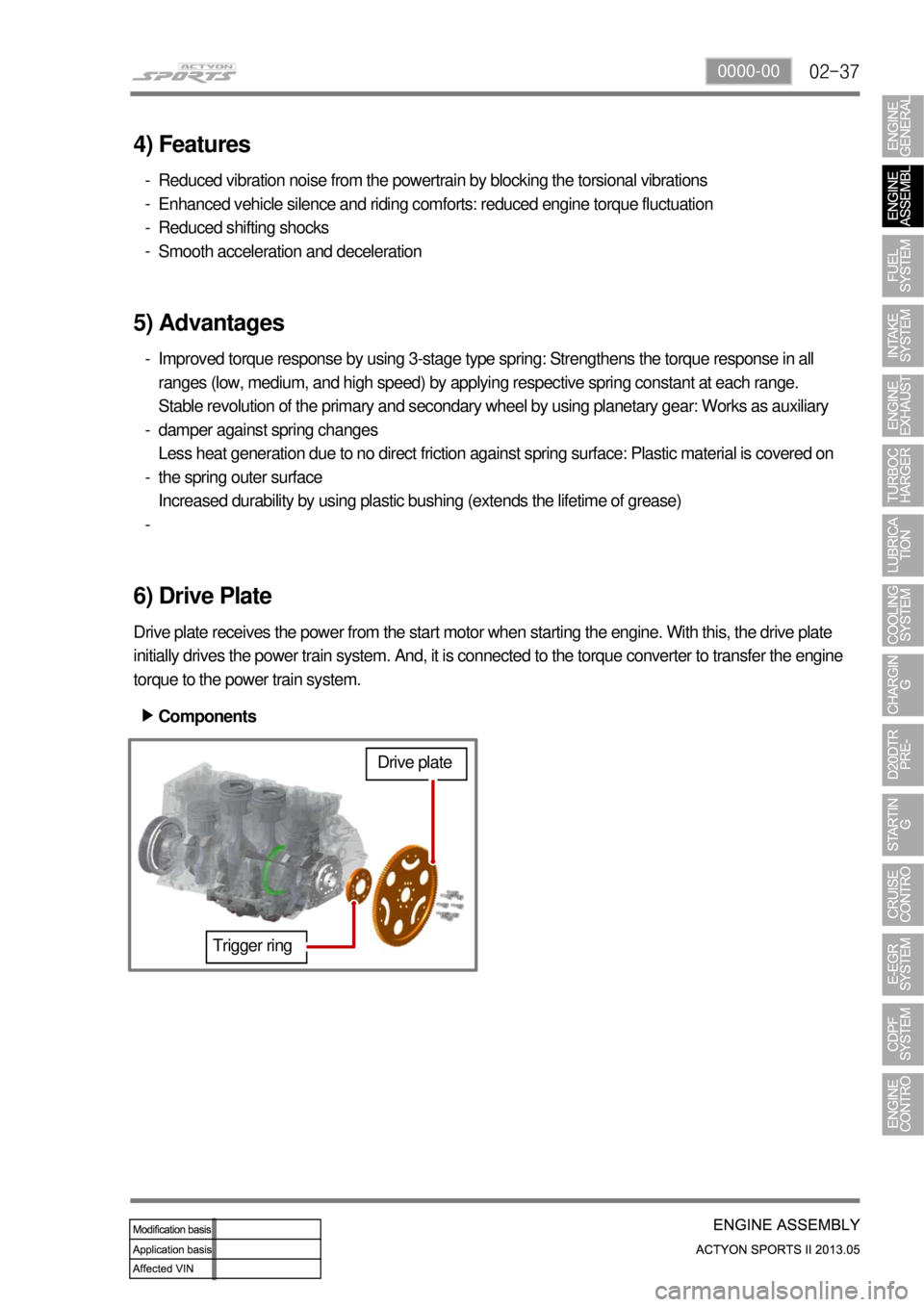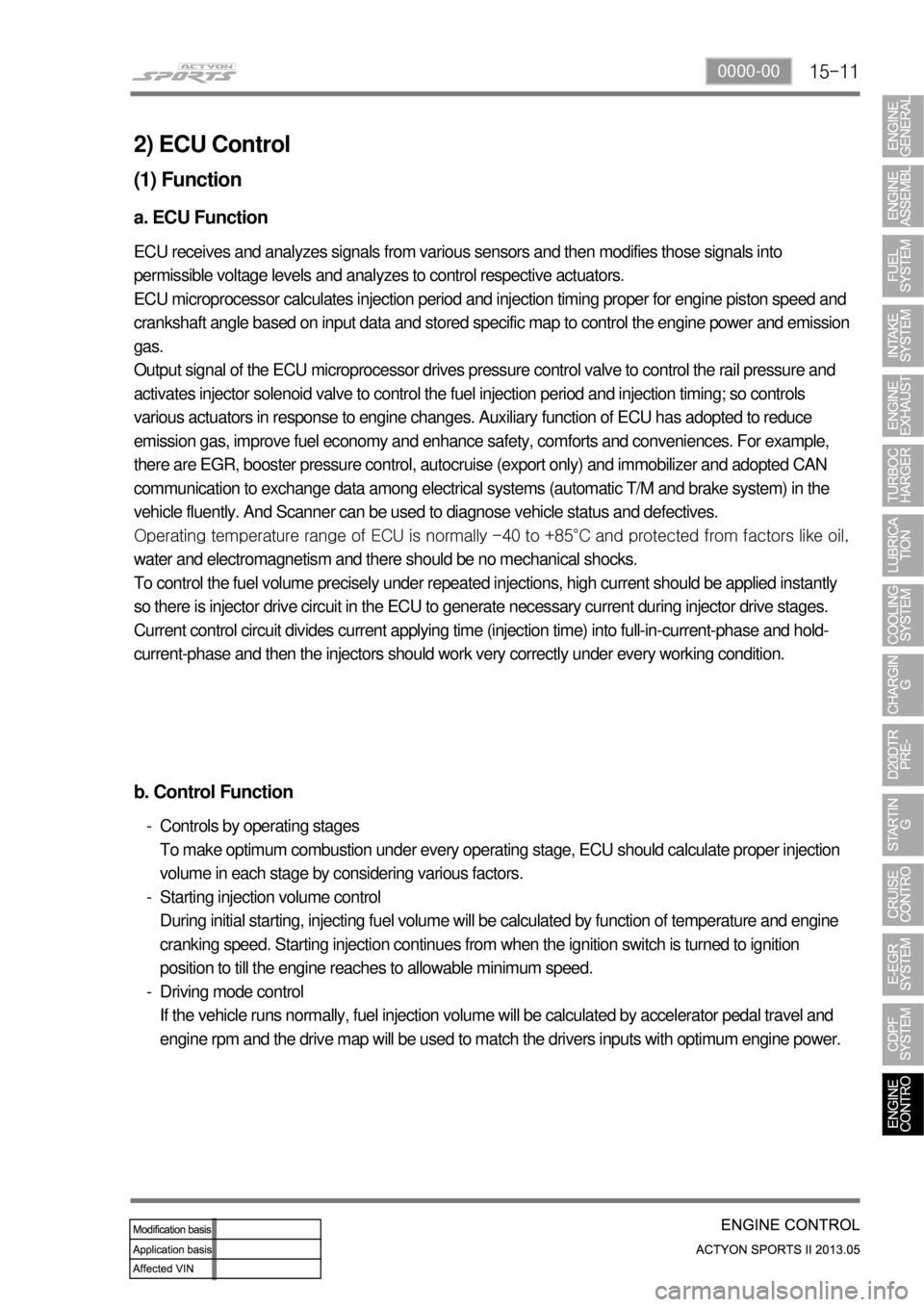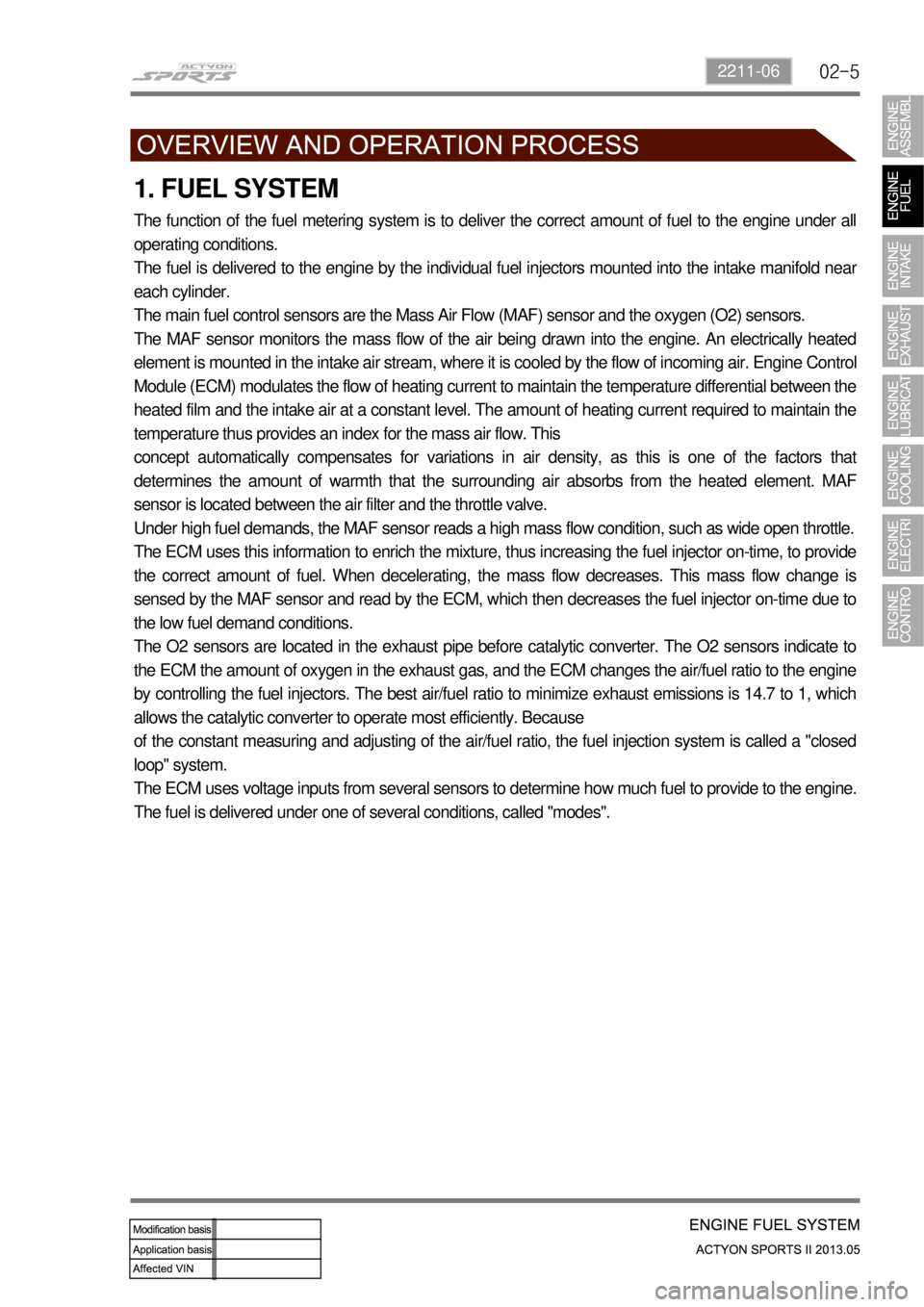2013 SSANGYONG NEW ACTYON SPORTS change time
[x] Cancel search: change timePage 68 of 751

02-370000-00
4) Features
Reduced vibration noise from the powertrain by blocking the torsional vibrations
Enhanced vehicle silence and riding comforts: reduced engine torque fluctuation
Reduced shifting shocks
Smooth acceleration and deceleration -
-
-
-
5) Advantages
Improved torque response by using 3-stage type spring: Strengthens the torque response in all
ranges (low, medium, and high speed) by applying respective spring constant at each range.
Stable revolution of the primary and secondary wheel by using planetary gear: Works as auxiliary
damper against spring changes
Less heat generation due to no direct friction against spring surface: Plastic material is covered on
the spring outer surface
Increased durability by using plastic bushing (extends the lifetime of grease) -
-
-
-
6) Drive Plate
Drive plate receives the power from the start motor when starting the engine. With this, the drive plate
initially drives the power train system. And, it is connected to the torque converter to transfer the engine
torque to the power train system.
Trigger ring
Drive plate
Components ▶
Page 137 of 751

07-31543-00
1. SPECIFICATION
The engine oil filter element should be changed at the same time with th\
e engine oil.Regularly check the engine oil level and add the engine oil if necessary\
.
Remember to check the engine oil level and shorten the cycle to replace \
the engine oil under
severe driving conditions.
-
-
Severe Driving Condition Frequent stop-and-go traffic, extended idling, short driving distance be\
low 6 km, driving distance
below 16 km when the outside temperature remains below freezing
Driving in a hilly or mountainous terrain, sandy, or dusty area
High load driving such as trailer towing
Taxi, patrol service or delivery service (extended idling and excessive\
driving with low speed)
-
-
-
-
Unit
Specification
Oil pump Lubrication system Gear pump, forced circulation
Type Inscribed gear
Capacity 63 L at 4,000 rpm
Relief pressure 5.8 bar ± 0.3 bar
Oil filter Type Full flow/Paper element
Engine oil Specified oil SAE 5W30 (approved by MB SHEET 229.51)
Capacity (L) Min.: 4.5 L
Max.: 6.0 L
Service interval Change every 15,000 km or 12 months (But, shorten the service interval under severe condition)
Oil injection nozzle Type Piston
Operating pressure 1.5bar
Closing pressure 1.0bar
Oil flow 4 L/min
Permissible pressure 10bar
Unit Specification
Oil pump Lubrication system Gear pump, forced circulation
Type Inscribed gear
Capacity 63L@4,000 rpm
Relief pressure 5.8 bar ± 0.3 bar
Oil filter Type Full flow/Paper element
Engine oil Specified oilSAE 5W30 (approved by MB SHEET 229.51)
Capacity (L) Min.: 4.5 L
Max.: 6.0 L
Service
interval EU Change every 20,000 km or 12 months
(The service interval should be shortened under
severe conditions)
General Change every 15,000 km or 12 months (The service interval should be shortened under
severe conditions)
Oil pressure switch
Page 211 of 751

15-110000-00
2) ECU Control
(1) Function
a. ECU Function
ECU receives and analyzes signals from various sensors and then modifies those signals into
permissible voltage levels and analyzes to control respective actuators.
ECU microprocessor calculates injection period and injection timing proper for engine piston speed and
crankshaft angle based on input data and stored specific map to control the engine power and emission
gas.
Output signal of the ECU microprocessor drives pressure control valve to control the rail pressure and
activates injector solenoid valve to control the fuel injection period and injection timing; so controls
various actuators in response to engine changes. Auxiliary function of ECU has adopted to reduce
emission gas, improve fuel economy and enhance safety, comforts and conveniences. For example,
there are EGR, booster pressure control, autocruise (export only) and immobilizer and adopted CAN
communication to exchange data among electrical systems (automatic T/M and brake system) in the
vehicle fluently. And Scanner can be used to diagnose vehicle status and defectives.
<00760097008c00990088009b00900095008e0047009b008c00940097008c00990088009b009c0099008c0047009900880095008e008c00470096008d0047006c006a007c00470090009a0047009500960099009400880093009300a000470054005b005700
47009b009600470052005f005c00b6006a004700880095008b> protected from factors like oil,
water and electromagnetism and there should be no mechanical shocks.
To control the fuel volume precisely under repeated injections, high current should be applied instantly
so there is injector drive circuit in the ECU to generate necessary current during injector drive stages.
Current control circuit divides current applying time (injection time) into full-in-current-phase and hold-
current-phase and then the injectors should work very correctly under every working condition.
b. Control Function
Controls by operating stages
To make optimum combustion under every operating stage, ECU should calculate proper injection
volume in each stage by considering various factors.
Starting injection volume control
During initial starting, injecting fuel volume will be calculated by function of temperature and engine
cranking speed. Starting injection continues from when the ignition switch is turned to ignition
position to till the engine reaches to allowable minimum speed.
Driving mode control
If the vehicle runs normally, fuel injection volume will be calculated by accelerator pedal travel and
engine rpm and the drive map will be used to match the drivers inputs with optimum engine power. -
-
-
Page 218 of 751

15-18
B. Driver Demand
The driver demand is the translation of the pedal position into the fuel demand. It is calculated as a
function of the pedal position and of the engine speed. The driver demand is filtered in order to limit the
hesitations caused by rapid changes of the pedal position. A mapping determines the maximum fuel
which can be injected as a function of the driver demand and the rail pressure. Since the flow is
proportional to the injection time and to the square root of the injection pressure, it is necessary to limit
the flow according to the pressure in order to avoid extending the injection for too long into the engine
cycle. The system compares the driver demand with this limit and chooses the smaller of the 2 values.
The driver demand is then corrected according to the coolant temperature. This correction is added to
the driver demand.
Page 274 of 751

02-52211-06
1. FUEL SYSTEM
The function of the fuel metering system is to deliver the correct amount of fuel to the engine under all
operating conditions.
The fuel is delivered to the engine by the individual fuel injectors mounted into the intake manifold nea
r
each cylinder.
The main fuel control sensors are the Mass Air Flow (MAF) sensor and the oxygen (O2) sensors.
The MAF sensor monitors the mass flow of the air being drawn into the engine. An electrically heated
element is mounted in the intake air stream, where it is cooled by the flow of incoming air. Engine Control
Module (ECM) modulates the flow of heating current to maintain the temperature differential between the
heated film and the intake air at a constant level. The amount of heating current required to maintain the
temperature thus provides an index for the mass air flow. This
concept automatically compensates for variations in air density, as this is one of the factors that
determines the amount of warmth that the surrounding air absorbs from the heated element. MAF
sensor is located between the air filter and the throttle valve.
Under high fuel demands, the MAF sensor reads a high mass flow condition, such as wide open throttle.
The ECM uses this information to enrich the mixture, thus increasing the fuel injector on-time, to provide
the correct amount of fuel. When decelerating, the mass flow decreases. This mass flow change is
sensed by the MAF sensor and read by the ECM, which then decreases the fuel injector on-time due to
the low fuel demand conditions.
The O2 sensors are located in the exhaust pipe before catalytic converter. The O2 sensors indicate to
the ECM the amount of oxygen in the exhaust gas, and the ECM changes the air/fuel ratio to the engine
by controlling the fuel injectors. The best air/fuel ratio to minimize exhaust emissions is 14.7 to 1, which
allows the catalytic converter to operate most efficiently. Because
of the constant measuring and adjusting of the air/fuel ratio, the fuel injection system is called a "closed
loop" system.
The ECM uses voltage inputs from several sensors to determine how much fuel to provide to the engine.
The fuel is delivered under one of several conditions, called "modes".
Page 275 of 751

02-6
1) Starting Mode
When the ignition is turned ON, the ECM turns the fuel pump relay on for 1 second. The fuel pump then
builds fuel pressure. The ECM also checks the Engine Coolant Temperature (ECT) sensor and the
Throttle Position (TP) sensor and determines the proper air/fuel ratio for starting the engine. This ranges
from1.5 to 1 at -36 °C (-33 °F) coolant temperature to 14.7 to 1 at 94 °C (201 °F) coolant
temperature. The ECM controls the amountof fuel delivered in the starting mode by changing how long
the fuel injector is turned on and off. This is done by ''pulsing" the fuel injectors for very short times.
2) Run Mode
The run mode has two conditions called ''open loop" and ''closed loop".
3) Open Loop
When the engine is first started and it is above 690 rpm, the system goes into "open loop" operation. In
"open loop", the ECM ignores the signal from the HO2S and calculates the air/fuel ratio based on inputs
from the ECT sensor and the MAF sensor. The ECM stays in "open loop" until the following conditions
are met:
The O2 has a varying voltage output, showing that it is hot enough to operate properly.
The ECT sensor is above a specified temperature (22.5 °C).
A specific amount of time has elapsed after starting the engine. -
-
-
4) Closed Loop
The specific values for the above conditions vary with different engines and are stored in the
Electronically Erasable Programmable Read-Only Memory (EEPROM).
When these conditions are met, the system goes into "closed loop" operation. In "closed loop", the ECM
calculates the air/fuel ratio (fuel injector on- time) based on the signals from the O2 sensors. This allows
the air/fuel ratio to stay very close to 14.7 to 1.
5) Acceleration Mode
The ECM responds to rapid changes in throttle position and airflow and provides extra fuel.
6) Deceleration Mode
The ECM responds to changes in throttle position and airflow and reduces the amount of fuel. When
deceleration is very fast, the ECM can cut off fuel completely for short periods of time.
Page 328 of 751

02-18
Check whether the multifunction wiper switch is in the "AUTO" position.
Check the power to the sensor. Check the conditions of the pin 3 (Groun\
d) and the pin 4
(IGN).
Check the wiper relay for defective.
1)
2)
3)
Symptom 2. It rains but the system does not work in "AUTO" position.
TROUBLE SHOOTING
▶
The wiper does not operate one cy cle when turning the multifunction
wiper switch to the "AUTO" from the "OFF" position or starting the
engine while the wiper switch is in the "AUTO" position.
When starting the engine with the multifunction wiper switch in the "AUTO" position, the
wiper operates one cycle to remind a driver that the wiper switch is in \
the "AUTO" position.
When the multifunction wiper switch is turned to "AUTO" from "OFF", the wiper operates
one cycle.
It always operates one cycle for the initial operation, however, the wiper does not operate
afterwards to prevent the wiper blade wear if not raining when turning the wiper sw\
itch to
"AUTO" from "OFF". However, the wiper operates up to 5 minutes after rain stops\
. If this
function does not occur, check No. 8 pin. If the pin is normal, check the wiper relay related
terminals.
1)
2)
Symptom 3. The wiper operates 3 or 4 times at high speed abruptly.
Check whether the variable resistance knob on the multifunction wiper switch i\
s set in
"FAST". The "FAST" is the highest stage of sensitivity and very sensitive to small amount o
f
rain drops. Therefore, change the knob to low sensitivity.
Symptom 4. The wiper operates continuoulsy even on the dry windshield glass.
Check the wiper blade for wear. If the wiper blade cannot wipe the glass uniformly and
clearly, this problem could be occurred. In this case, replace the wiper\
blade with new one.
Check whether the variable resistance knob on the multifunction wiper switch is set in
"FAST" The "FAST" is the highest stage of sensitivity and very sensitive\
to small amount o
f
rain drops. Therefore, change the knob to low sensitivity.
1)
2)
Symptom 1.
Page 351 of 751

02-418710-01
The door lock system outputs "LOCK" when the vehicle speed maintains over 30 km/h.
However, it doesn't output "LOCK" when all doors are locked or failed.
If any of doors is unlocked after outputting "LOCK" in step 1, outputs "LOCK" up to 5 times
(except step (1)) at the interval of one second.
If any of doors is unlocked after 5 times of "LOCK" outputs, the door (driver's/passenger's/rear) is
regarded as "FAIL".
If the door that was regarded as fail is changed (UNLOCK to LOCK), it will be recognized as a
normal one.
If any door is regarded as FAIL, the auto door lock function does not work. (if it is occurred when
the vehicle speed is over 30 km/h, the auto door lock output does not occur even if the vehicle
speed falls below 30 km/h and accelerates again to over 30 km/h.) Nonetheless, the central
door lock function works properly.
When the system receives "UNLOCK" signal fr om a door switch, it outputs "LOCK" signals 5
times. If additional "LOCK" signal from another door switch is detected during \
the period, the
system outputs five "LOCK" signals 5 times for the switch.
The door lock system outputs "UNLOCK" automatically if the "LOCK" output conditions are
established by this function or the key is cycled (IGN=OFF) (even when there is no "LOCK"
output while the vehicle speed maintains over 30 km/h under lock conditi\
on).
(If the LOCK condition is established with the ignition switch ON, the system outputs UNLOCK
signal unconditionally when turning the ignition switch to OFF position.\
)
However, when the ignition key is turned to "OFF" position, the lock output conditions will be
cancelled.
The "FAIL" condition of the door will be erased when the ignition key is\
turned to "OFF" position.
1.
2.
3.
4.
5.
6.
7.
8.
▶Auto Door Lock
T2: 0.5 s
(*1) LOCK: Driver's & Passenger's & Rear door & = Lock